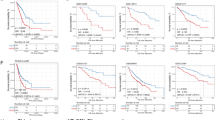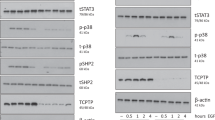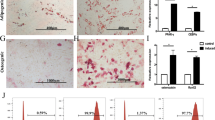Abstract
There is some evidence that treatment with interleukin-2 (IL-2) and interferon-alpha (IFNα) frequently induces depressive symptoms and activation of the inflammatory response system (IRS). There is evidence that major depression is accompanied by lowered serum activity of dipeptidyl peptidase IV (DPP IV; EC 3.4.14.5), a membrane-bound serine protease which catalyses the cleavage of some cytokines and neuro-active peptides and which modulates T cell activation and the production of cytokines, such as IL-2. This study was carried out to examine the effects of immunochemotherapy with IL-2 and IFNα, alone and together, in cancer patients on serum DPP IV activity in relation to changes in depressive symptoms and the IRS. The Montgomery and Asberg Rating Scale (MADRS), serum DPP IV activity, and the serum IL-6, and IL-2 receptor (IL-2R) concentrations were measured in 26 patients with metastatic cancers before and three and five days after treatment with IL-2 and IFNα, alone or together. Treatment with IL-2 with or without IFNα significantly suppressed serum DPP IV activity. The MADRS scores were significantly elevated by treatment with IL-2 with or without IFNα, but not IFNα alone. The immunochemotherapy-induced decreases in serum DPP IV were significantly and inversely correlated with the increases in the MADRS. Treatment with IL-2 alone or combined with IFNα also elevated serum IL-6 and IL-2R. There were significant and inverse correlations between the immuchemotherapy-induced decreases in serum DPP IV and the elevations in serum IL-6 or IL-2R. In conclusion, treatment with IL-2/IFNα decreases serum DPP IV activity within 3–5 days and the immunochemotherapy-induced decreases in serum DPP IV activity are significantly and inversely related to treatment-induced increases in severity of depression and signs of activation of the IRS.
Similar content being viewed by others
Log in or create a free account to read this content
Gain free access to this article, as well as selected content from this journal and more on nature.com
or
References
Anisman H, Kokkinidis L, Borowski T, Merali Z . (1998): Differential effects of interleukin (IL)-1beta, IL-2 and IL-6 on responding for rewarding lateral hypothalamic stimulation. Brain Res 779: 177–187
Ansorge S, Schon E . (1987): Dipeptidyl peptidase IV (DP IV), a functional marker of the T lymphocyte system. Acta Histochem 82: 41–46
Baron DA, Hardie T, Baron SH . (1993): Possible association of interleukin-2 treatment with depression and suicide. J Am Osteopath Assoc 93: 799–800
Barton RW, Prendergast J, Kennedy CA . (1990): Binding of the T cell activation monoclonal antibody TA1 to dipeptidyl peptidase IV. J Leukoc Biol 48: 291–296
Bluthé RM, Crestani F, Kelley KW, Dantzer R . (1992): Mechanisms of the behavioral effects of interleukin 1. Ann NY Acad Sci 650: 268–275
Capuron L, Ravaud A . (1999): Prediction of the depressive effects of interferon alfa therapy by the patient's initial affective state. N Engl J Med 340: 1370
Capuron L, Ravaud A, Dantzer R . (2000): Early depressive symptoms in cancer patients receiving interleukin-2 and/or interferon alpha therapy. J Clin Oncol in press.
Cavaillon J-M . (1996): Les Cytokines. Paris, Masson
Chen WT . (1996): Proteases associated with invadopodia, and their role in degradation of extracellular matrix. Enzyme Prot 49: 59–71
Cheng HC, Abdel-Ghany M, Elble RC, Pauli BU . (1998): Lung endothelial dipeptidyl peptidase IV promotes adhesion and metastasis of rat breast cancer cells via tumor cell surface-associated fibronectin. J Biol Chem 273: 24207–24215
Conlon JM, Sheehan L . (1983): Conversion of substance P to C-terminal fragments in human plasma. Regul Pept 7: 335–345
Connor TJ, Song C, Leonard BE, Merali Z, Anisman H . (1998): An assessment of the effects of central interleukin-1beta, -2, -6, and tumor necrosis factor-alpha administration on some behavioural, neurochemical, endocrine and immune parameters in the rat. Neuroscience 84: 923–933
Dantzer R, Bluthé RM, Laye S, Bret-Dibat JL, Parnet P, Kelley KW . (1998): Cytokines and sickness behavior. Ann NY Acad Sci 840: 586–590
Davis GL, Esteban-Mur R, Rustgi V, Hoefs J, Gordon SC, Trepo C, Shiffman ML, Zeuzem S, Craxi A, Ling MH, Albrecht J . (1998): Interferon alfa-2b alone or in combination with ribavirin for the treatment of relapse of chronic hepatitis C. International Hepatitis Interventional Therapy Group. N Engl J Med 339: 1493–1499
De Meester IAJ . (1992): Characterization of human lymphocytic dipeptidyl peptidase IV and its identification as the activation antigen CD 26. Ph.D. Thesis, Antwerp.
De Meester IAJ, Mertens AV, De Clerck LS, Scharpé S, Bridts CH, Stevens WJ . (1993): Correlations between dipeptidyl peptidase IV and disease activity of rheumatoid arthritis (RA). J Allergy Clin Immunol 91: 228–232
De Meester IAJ, Korom S, Van Damme J, Scharpe S . (1999): CD26, let it cut or cut it down. Immunol Today 20: 367–375
Denicoff KD, Rubinow DR, Papa MZ, Simpson C, Seipp CA, Lotze MT, Chang AE, Rosenstein D, Rosenberg SA . (1987): The neuropsychiatric effects of treatment with interleukin-2 and lymphokine-activated killer cells. Ann Intern Med 107: 293–300
De Paoli P, Zanussi S, Simonelli C, Bortolin MT, D'Andrea M, Crepaldi C, Talamini R, Comar M, Giacca M, Tirelli U . (1997): Effects of subcutaneous interleukin-2 therapy on CD4 subsets and in vitro cytokine production in HIV+ subjects. J Clin Invest 100: 2737–2743
Duke-Cohan JS, Morimoto C, Rocker JA, Schlossman SF . (1995): A novel form of dipeptidylpeptidase IV found in human serum: Isolation, characterization, and comparison with T lymphocyte membrane dipeptidylpeptidase IV (CD26). J Biol Chem 270: 14107–14114
Elgun S, Keskinege A, Kumbasar H . (1999): Dipeptidyl peptidase IV and adenosine deaminase activity. Decrease in depression. Psychoneuroendocrinology 24: 823–832
Eton O, Talpaz M, Lee KH, Rothberg JM, Brell JM, Benjamin RS . (1996): Phase II trial of recombinant human interleukin-2 and interferon-alpha-2a: implications for the treatment of patients with metastatic melanoma. Cancer 77: 893–899
Frohman L, Downs T, Heimer E, Felix A . (1989): Dipeptidyl peptidase IV and trypsin-like enzymatic degradation of human growth hormone releasing hormone in plasma. J Clin Invest 83: 1533–1540
Fujita K, Hirano M, Ochiai J, Funabashi M, Nagatsu I, Nagatsu T, Sakakibara S . (1978): Serum glycylproline p-nitroanilidase activity in rheumatoid arthritis and systemic lupus erythematosus. Clin Chem 88: 15–20
Grob JJ, Dreno B, de la Salmoniere P, Delaunay M, Cupissol D, Guillot B, Souteyrand P, Sassolas B, Cesarini JP, Lionnet S, Lok C, Chastang C, Bonerandi JJ . (1998): Randomised trial of interferon alpha-2a as adjuvant therapy in resected primary melanoma thicker than 1.5 mm without clinically detectable node metastases. French Cooperative Group on Melanoma. Lancet 351: 1905–1910
Guilhot F, Chastang C, Michallet M, Guerci A, Harousseau JL, Maloisel F, Bouabdallah R, Guyotat D, Cheron N, Nicolini F, Abgrall JF, Tanzer J . (1997): Interferon alfa-2b combined with cytarabine versus interferon alone in chronic myelogenous leukemia. French Chronic Myeloid Leukemia Study Group. N Engl J Med 337: 223–229
Gutterman JU, Fine S, Quesada J, Horning SJ, Levine JF, Alexanian R, Bernhardt L, Kramer M, Spiegel H, Colburn W, Trown P, Merigan T, Dziewanowski Z . (1982): Recombinant leukocyte A interferon: Pharmacokinetics, single-dose tolerance, and biologic effects in cancer patients. Ann Intern Med 96: 549–556
Hopsu-Havu VK, Glenner GG . (1966): A new dipeptide naphthylamidase hydrolyzing glycyl-propyl-á-naphthylamide. Histochemistry 7: 197–201
Howell DC . (1982): In Statistical Methods for Psychology. Boston, Duxbury Press
Iwaki-Egawa S, Watanabe Y, Fujimoto Y . (1995): Is CD26/dipeptidyl peptidase IV a really important molecule in T cell activation of a certain rat strain. Immunobiology 194: 429–442
Janssen HL, Brouwer JT, van der Mast RC, Schalm SW . (1994a): Suicide associated with alfa-interferon therapy for chronic viral hepatitis. J Hepatol 21: 241–243
Janssen RA, Mulder NH, The TH, de Leij L . (1994b): The immunobiological effects of interleukin-2 in vivo. Cancer Immunol Immunother 39: 207–216
Joffe JK, Banks RE, Forbes MA, Hallam S, Jenkins A, Patel PM, Hall GD, Velikova G, Adams J, Crossley A, Johnson PW, Whicher JT, Selby PJ . (1996): A phase II study of interferon-alpha, interleukin-2 and 5-fluorouracil in advanced renal carcinoma: Clinical data and laboratory evidence of protease activation. Br J Urol 77: 638–649
Kasahara Y, Leroux-Roels G, Nakamura R, Chisari F . (1984): Glycylprolyl-diaminopeptidase in human leukocytes: Selective occurrence in T lymphocytes and influence on the total serum enzyme activity. Clin Chim Acta 139: 295–302
Kehlen A, Gohring B, Langner J, Riemann D . (1998): Regulation of the expression of aminopeptidase A, aminopeptidase N/CD13 and dipeptidylpeptidase IV/CD 26 in renal carcinoma cells and renal tubular epithelial cells by cytokines and cAMP-increasing mediators. Clin Exp Immunol 111: 435–441
Kirkwood JM, Strawderman MH, Ernstoff MS, Smith TJ, Borden EC, Blum RH . (1996): Interferon alfa-2b adjuvant therapy of high-risk resected cutaneous melanoma: The Eastern Cooperative Oncology Group Trial EST 1684. J Clin Oncol 14: 7–17
Linthorst AC, Reul JM . (1998): Brain neurotransmission during peripheral inflammation. Ann NY Acad Sci 840: 139–152
Maes M . (1999): Major depression and activation of the inflammatory response system. Adv Exp Med Biology 461: 25–46
Maes M, De Meester I, Vanhoof G, Scharpé S, Bosmans E, Vandervorst C, Verkerk R, Minner B, Suy E, Raus J . (1991): Decreased serum dipeptidyl peptidase IV activity in major depression. Biol Psychiatry 30: 577–586
Maes M, Scharpé S, De Meester I, Goossens P, Wauters A, Neels H, Verkerk R, De Meyer F, D'Hondt P, Peeters D, Schotte C, Cosyns P . (1994): Components of biological variation in plasma prolyl endopeptidase and dipeptidyl peptidase activity in healthy man. Clin Chem 40: 1686–1691
Maes M, De Meester I, Verkerk R, Demedts P, Wauters A, Vanhoof G, Vandoolaeghe E, Neels H, Scharpe S . (1997): Dipeptidyl peptidase serum activity in treatment resistant depression: Relationships with immune-inflammatory markers. Psychoneuroendocrinology 22: 65–78
Maier SF, Watkins LR . (1995): Intracerebroventricular interleukin-1 receptor antagonist blocks the enhancement of fear conditioning and interference with escape produced by inescapable shock. Brain Res 695: 279–282
Maier SF, Watkins LR . (1998): Cytokines for psychologists: implications of bidirectional immune-to-brain communication for understanding behavior, mood, and cognition. Psychol Rev 105: 83–107
Mattern T, Scholz W, Feller AC, Flad HD, Ulmer AJ . (1991): Expression of CD26 (Dipeptidyl peptidase IV) on resting and activated human lymphocytes-T. Scand J Immunol 33: 737–748
Meffert M, Hanninen EL, Menzel T, Schomburg A, Duensing S, Dallmann I, Grosse J, Vocke S, Buer J, Deckert M, et al. (1994): In vivo time and dose dependency of interleukin-6 secretion in response to low-dose subcutaneous recombinant interleukin-2. Cancer Biother 9: 307–316
McHutchison JG, Gordon SC, Schiff ER, Shiffman ML, Lee WM, Rustgi VK, Goodman ZD, Ling MH, Cort S, Albrecht JK . (1998): Interferon alfa-2b alone or in combination with ribavirin as initial treatment for chronic hepatitis C. Hepatitis Interventional Therapy Group. N Engl J Med 339: 1485–1492
Mentlein R, Dahms P, Grandt D, Kruger R . (1993): Proteolytic processing of neuropeptide Y and peptide YY by dipeptidyl peptidase IV. Regul Pept 49: 133–144
Montgomery SA, Asberg A . (1979): A new depression scale designed to be sensitive to change. Br J Psychiatry 134: 382–389
Nagatsu T, Hino M, Fuyamada H, Hayakawa T, Sakibara S, Nakagawa Y, Takemoto T . (1976): New chromogenic substrates for X-Pro dipeptidyl aminopeptidase. Anal Biochem 74: 466–476
Reinhold D, Wrenger S, Bank U, Buhling F, Hoffmann T, Neubert K, Kraft M, Frank R, Ansorge S . (1996): CD26 mediates the action of HIV-1 Tat protein on DNA synthesis and cytokine production in U937 cells. Immunobiology 195: 119–128
Riemann D, Kehlen A, Langner J . (1995): Stimulation of the expression and the enzyme activity of aminopeptidase N/CD 13 and dipeptidylpeptidase IV/CD 26 on human renal cell carcinoma cells and renal tubular epithelial cells by T cell-derived cytokines, such as IL-4 and IL-13. Clin Exp Immunol 100: 277–283
Ruiz P, Zacharievich N, Hao L, Viciana AL, Shenkin M . (1998): Human thymocyte dipeptidyl peptidase IV (CD26) activity is altered with stage of ontogeny. Clin Immunol Immunopathol 88: 156–168
Sakic B, Szechtman H, Braciak T, Richards C, Gauldie J, Denburg JA . (1997): Reduced preference for sucrose in autoimmune mice: A possible role of interleukin-6. Brain Res Bull 44: 155–165
Scharpé S, De Meester I, Vanhoof G, Hendriks D, Uyttenbroeck W, Ntakarutimana V, Deckx R . (1990): Serum DPP IV activity in transplant recipients. Clin Chem 36: 984
Schmitz T, Underwood R, Khiroya R, Bachovchin WW, Huber BT . (1996): Potentiation of the immune response in HIV-1+ individuals. J Clin Invest 97: 1545–1549
Schnittman SM, Vogel S, Baseler M, Lane HC, Davey RT Jr . (1994): A phase I study of interferon-alpha 2b in combination with interleukin-2 in patients with human immunodeficiency virus infection. J Infect Dis 169: 981–989
Scholz W, Mentlein R, Heymann E, Feller AC, Ulmer AJ, Flad HD . (1985): Interleukin 2 production by human T lymphocytes identified by antibodies to dipeptidyl peptidase IV. Cell Immunol 93: 199–211
Schon E, Demuth H-U, Eichmann E, Horst H-J, Korner I-J, Kopp J, Mattern T, Neubert K, Noll F, Ulmer AJ, Barth A, Ansorge S . (1989): Dipeptidyl peptidase IV in human T lymphocytes. Impaired induction of interleukin 2 and gamma interferon due to specific inhibition of dipeptidyl peptidase IV. Scand J Immunol 29: 127–132
Spath-Schwalbe E, Hansen K, Schmidt F, Schrezenmeier H, Marshall L, Burger K, Fehm HL, Born J . (1998): Acute effects of recombinant human interleukin-6 on endocrine and central nervous sleep functions in healthy men. J Clin Endocrinol Metab 83: 1573–1579
Tanaka T, Duke-Cohan JS, Kameoka J, Yaron A, Lee I, Schlossman SF, Morimoto C . (1994): Enhancement of antigen-induced T-cell proliferation by soluble CD26/dipeptidyl peptidase IV. Proc Natl Acad Sci U S A 91: 3082–3086
Taylor JL, Grossberg SE . (1998): The effects of interferon-alpha on the production and action of other cytokines. Semin Oncol 25(Suppl 1): 23–29
Uematsu T, Urade M, Yamaoka M . (1998): Decreased expression and release of dipeptidyl peptidase IV (CD26) in cultured peripheral blood T lymphocytes of oral cancer patients. J Oral Pathol Med 27: 106–110
Valentine AD, Meyers CA, Kling MA, Richelson E, Hauser P . (1998): Mood and cognitive side effects of interferon-alpha therapy. Semin Oncol 25(Suppl 1): 39–47
Van Gool AR, Kruit WHJ, Cornelissen JJ, Berk L, Eggermont AMM, Bannink M . (1999): Management of psychiatric adverse events with immunotherapy with interferon-alpha. Acta Neuropsychiatrica 11: 120–124
Van Hoof G, De Meester I, van Sande M, Scharpé S, Yaron A . (1992): Distribution of proline-specific aminopeptidases in human tissues and body fluids. Eur J Clin Chem Clin Biochem 30: 333–338
Van Hoof G, Goossens F, De Meester I, Hendriks D, Scharpé S . (1995): Proline motifs in peptides and their biological processing. FASEB J 9: 736–744
Walker LG, Walker MB, Heys SD, Lolley J, Wesnes K, Eremin O . (1997): The psychological and psychiatric effects of rIL-2 therapy: a controlled clinical trial. Psychooncology 6: 290–301
Yamabe T, Takakura K, Sugie K, Kitaoka Y, Takeda S, Okubo Y, Teshigawara K, Yodoi J, Hori T . (1997): Induction of the 2B9 antigen/dipeptidyl peptidase IV/CD26 on human natural killer cells by IL-2, IL-12 or IL-15. Immunology 91: 151–158
Yirmiya R . (1996): Endotoxin produces a depressive-like episode in rats. Brain Res 711: 163–174
Yirmiya R . (1997): Behavioral and psychological effect of immune activation: Implications for depression due a general medical condition. Curr Opin Psychiatry 10: 470–476
Zukowska-Grojec Z . (1997): Neuropeptide Y: Implications in vascular remodeling and novel therapeutics. Drugs News Perspect 10: 587–595
Author information
Authors and Affiliations
Rights and permissions
About this article
Cite this article
Maes, M., Capuron, L., Ravaud, A. et al. Lowered Serum Dipeptidyl Peptidase IV Activity is Associated with Depressive Symptoms and Cytokine Production in Cancer Patients Receiving Interleukin-2-Based Immunotherapy. Neuropsychopharmacol 24, 130–140 (2001). https://doi.org/10.1016/S0893-133X(00)00168-8
Received:
Revised:
Accepted:
Issue date:
DOI: https://doi.org/10.1016/S0893-133X(00)00168-8
Keywords
This article is cited by
-
Inflammation and depression in young people: a systematic review and proposed inflammatory pathways
Molecular Psychiatry (2022)
-
Tryptophan degradation in women with breast cancer: a pilot study
BMC Research Notes (2011)
-
The inflammatory & neurodegenerative (I&ND) hypothesis of depression: leads for future research and new drug developments in depression
Metabolic Brain Disease (2009)
-
Serum cortisol, immunoglobulins and some complements among depressed patients
Indian Journal of Clinical Biochemistry (2008)
-
Serotonergic vulnerability and depression: assumptions, experimental evidence and implications
Molecular Psychiatry (2007)



